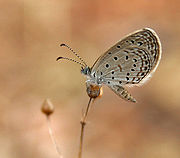
Zizula hylax
Encyclopedia

Lycaenidae
The Lycaenidae are the second-largest family of butterflies, with about 6000 species worldwide, whose members are also called gossamer-winged butterflies...
butterfly.
Description

Underside: grey. Fore wing: a dusky brown lunular line on the discocellulars; two subcostal spots above the cell, one on either side of the discocellular lunule; a very strongly curved discal series of five spots, of which the posterior three are somewhat lunular in shape and placed obliquely en echelon, the next above these hook-shaped, the anterior spot round; both the subcostal spots and the spots of the discal series are black, each narrowly encircled with white; beyond these are inner and outer subterminal dusky lines, which anteriorly are continuous, posteriorly somewhat broken and macular, followed by a very conspicuous jet-black anticiliary slender line. Cilia greyish white, traversed by a medial transverse blackish-brown line. Hind wing: with the following small white-encircled black spots: a subbasal transverse series of three, followed by a highly curved series of eight spots, that curve across the disc of the wing to the costa and along the latter towards the base; discocellulars with a dusky short lunular line as on the fore wing; terminal markings and cilia similar, but the outer and broader subterminal line more broken and macular than on the fore wing. Antennae black, the shafts ringed with white; head, thorax and abdomen dark brown, with a little violet pubescence on the head and thorax; beneath: palpi, thorax and abdomen greyish white.

Distribution
The Tiny Grass Blue is found in several races throughout tropical and subtropical Africa, Asia, and Oceania, including India, Japan, the Philippines, Singapore, Swaziland, north and east coasts of Australia and also in southern Australia.Life History
The wing span of the adults is about 1.5 centimetre (0.590551181102362 in). The eggs are pale green, round, and flattened, with a diameter of about 0.5 millimetre (0.0196850393700787 in). They are laid singly on buds and flowers of a foodplant. The caterpillars are 0.7 centimetre (0.275590551181102 in) long, green with a dark red line along the back, and light and dark lines partway along the sides. The sides are hairy, and the head is pale brown. The pupa is 0.7 cm long, hairy and green, and is attached to a stem or the underside of a leaf of a foodplant.
Foodplants
Foodplants include various members of the family AcanthaceaeAcanthaceae
The family Acanthaceae is a taxon of dicotyledonous flowering plants containing almost 250 genera and about 2500 species....
. Species noted include Hygrophila auriculata
Hygrophila auriculata
Hygrophila auriculata is a plant in the acanthus family. It is native to India and commonly known as marsh barbel....
and Phaulopsis dorsiflora.
General reading
, 1965. Comment on the proposed designation of a type species for Pithecops Horsfield, 1828. Z.N (S.) 1675. Bulletin of Zoological Nomenclature 22(4):209-210.- Evans, W.H. (1932) The Identification of Indian Butterflies. (2nd Ed), Bombay Natural History Society, Mumbai, India
- Gaonkar, Harish (1996) Butterflies of the Western Ghats, India (including Sri Lanka) – A Biodiversity Assessment of a threatened mountain system. Journal of the Bombay Natural History Society.
- Gay,Thomas; Kehimkar,Isaac & Punetha,J.C.(1992) Common Butterflies of India. WWF-India and Oxford University Press, Mumbai, India.
- Haribal, Meena (1994) Butterflies of Sikkim Himalaya and their Natural History.
- ICZN. Opinion 822, 1967. Pithecops Horsfield, [1828] designation of a type species under the plenary powers. Bulletin of Zoological Nomenclature 24(4):216-217.
- Kunte,Krushnamegh (2005) Butterflies of Peninsular India. Universities Press.
- Wynter-Blyth, M.A. (1957) Butterflies of the Indian Region, Bombay Natural History Society, Mumbai, India.
External links
- Asahi Correctly determined photos of Zizula hylax (synonym)from the PhilippinesPhilippinesThe Philippines , officially known as the Republic of the Philippines , is a country in Southeast Asia in the western Pacific Ocean. To its north across the Luzon Strait lies Taiwan. West across the South China Sea sits Vietnam...
.

